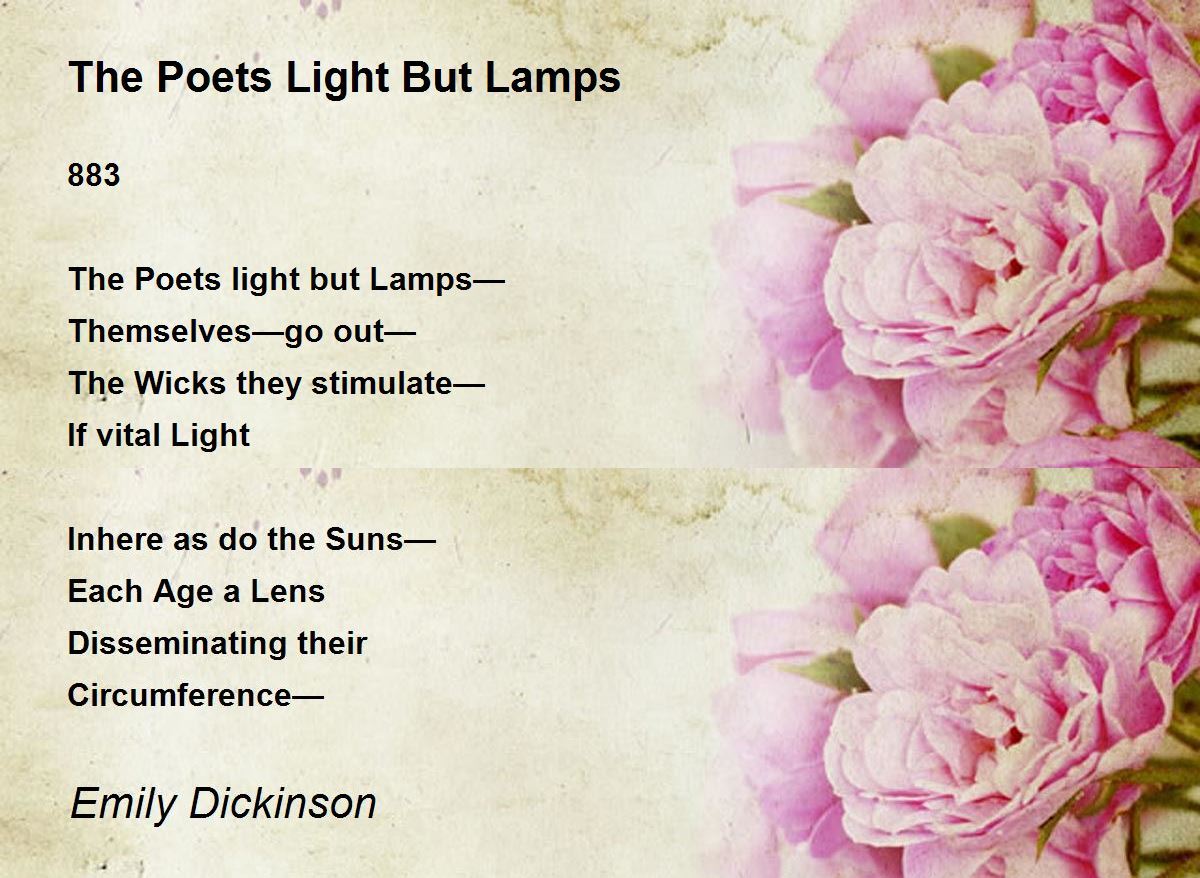
Emily Dickinson’s Lantern Poem
Emily Dickinson’s "The Wind" is a poignant and evocative depiction of the human experience in the face of life’s uncertainties and the indomitable spirit that carries us through. The poem opens with a vivid metaphor of a lantern, a beacon of hope amidst the darkness and desolation:
"The Wind begun to knead the Grass—
As Men my Dough—"
The wind’s relentless agitation of the grass echoes the tumultuous forces that buffet our own lives, bending and shaping us in unforeseen ways. The comparison to dough being kneaded suggests a sense of being molded and manipulated by external forces beyond our control.
As the poem progresses, the wind becomes a representation of the relentless forward march of time and the inevitability of change:
"The Earthy Anaesthetic numbs –
It scatters far and wide–"
The "earthy anesthetic" of the wind dulls our senses, rendering us oblivious to the pain and hardships that lie ahead. It "scatters" us, sending us on different paths, often beyond our own choosing.
Yet, amidst the turmoil and uncertainty, the poem concludes on a note of resilience and hope:
"The Wind blew till the Crumbs were gone—
Had left a Breeze or two—"
Even when the trials and tribulations of life have stripped us down to our barest essentials, a vestige of hope remains. The "breeze or two" represents the enduring spirit within us, the flame that keeps flickering even in the darkest of times.
Alternative Poem Writing Styles
The theme of Emily Dickinson’s Lantern Poem lends itself to a wide range of poem writing styles, each highlighting a different aspect of the human experience:
- Free Verse: A raw and unconstrained style that allows for the free flow of thoughts and emotions, capturing the tumultuous nature of the wind and the uncertainty of life.
- Blank Verse: A more structured form of poetry that uses unrhymed iambic pentameter, providing a rhythmic flow that mirrors the relentless march of time.
- Haiku: A concise three-line form that uses juxtaposition and imagery to evoke a fleeting moment or an enduring truth, such as the fleeting nature of hope or the resilience of the spirit.
- Lyric Poetry: A song-like style that expresses personal emotions and experiences, lending itself to the introspective and contemplative nature of Dickinson’s poem.
Poems Inspired by Emily Dickinson’s Lantern Poem
The Winds of Change
The wind kneads the grass,
Like dough in a baker’s hand,
Reshaping our world anew.
It scatters our dreams,
Like leaves upon the breeze,
Carrying us away to distant lands.
But even when the wind has passed,
A glimmer of hope remains,
A flame that flickers through the dark.
The Lantern of Life
In the darkness of life’s storms,
A lantern shines, a beacon of hope,
Guiding us through the uncharted seas.
Its light flickers and dances,
A constant presence in the chaos,
A reminder that we are not alone.
Though the winds may howl,
And the waves may crash,
The lantern’s flame burns bright.
A Whispered Promise
When the wind has taken all,
And the darkness threatens to consume,
Listen for a whispered promise.
It comes from within,
A spark of hope that cannot be extinguished,
A flame that will guide you home.
How to Write a Poem about Emily Dickinson’s Lantern Poem
- Read Dickinson’s Poem: Immerse yourself in the imagery and themes of the original poem to draw inspiration and capture its essence.
- Choose a Style: Determine the poem writing style that best suits your interpretation of the theme, whether it’s free verse, blank verse, haiku, or lyric poetry.
- Use Vivid Imagery: Create vivid and evocative images that capture the wind’s relentless force, the uncertainty of life, and the resilience of the human spirit.
- Explore Metaphor and Symbolism: Utilize metaphors and symbols to convey deeper meanings and emotions, such as the lantern as a beacon of hope or the wind as a force of change.
- End on a Note of Hope: Even in the face of adversity, Dickinson’s poem concludes with a glimmer of hope. Strive to do the same in your own poem.
Tips for Reading Good Poetry
- Read Aloud: Hearing the words spoken aloud can enhance your understanding and appreciation of the poem’s rhythm and flow.
- Analyze Language: Pay attention to the poet’s choice of words, imagery, and figurative language. Consider how these elements contribute to the meaning and emotional impact of the poem.
- Explore Context: Research the poet’s life and the historical and cultural context in which the poem was written to gain a deeper understanding of its themes and perspectives.
Questions and Answers
What is the main theme of Emily Dickinson’s Lantern Poem?
The main theme is the human experience in the face of life’s uncertainties and the indomitable spirit that carries us through.What literary devices does Dickinson use in the poem?
She uses metaphors (lantern, wind, grass), imagery (kneading dough, earthly anesthetic), and symbols (lantern as hope, wind as change).How can you apply the tips for writing good poetry to this poem?
By using vivid imagery, exploring metaphor and symbolism, and ending on a note of hope.
Thank You and Invitation
Thank you for reading my exploration of Emily Dickinson’s Lantern Poem and the various ways it can inspire poetic expression. Remember, poetry is meant to be shared and enjoyed, not plagiarized. Please credit the original authors when referencing their work, and feel free to share your own poetic interpretations and insights.
